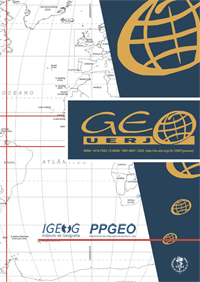CHAPECÓ: estrutura e dinâmica de uma cidade média no oeste catarinense
DOI:
https://doi.org/10.12957/geouerj.2013.6918Resumen
DOI: 10.12957/geouerj.2013.6918
Este artigo apresenta uma análise sobre Chapecó, na região oeste catarinense, tomada apartir da interpretação das transformações produtivas, impulsionadas por novos outradicionais agentes econômicos, e suas implicações sociais (populacionais e nomercado local e regional de trabalho), bem como a contribuição para o acirramento dedesigualdades socioespaciais e os processos de reestruturação urbana e regionaldecorrentes. Para tanto, valeu-se de pesquisa tanto quantitativa como qualitativa, a partirde dados primários, secundários e de campo. Conclui-se que o tradicional papel de Chapecó, associado às funções de intermediação das atividades agroindustriais, ainda semantém. Todavia, a diversificação do terciário, a entrada recente de agentes econômicosexternos e a chegada de uma instituição de ensino superior federal podem sugerir quenovos papéis se descortinam, de modo a refuncionalizar, em parte, a cidade na redeurbana regional. Persistem, todavia, os desafios quanto ao enfrentamento dasdesigualdades sociais e regionais e dos impactos ambientais engendrados no processode (re)estruturação urbana e regional.
Palavras-chave: Cidade Média; Reestruturação Econômica; Reestruturação Urbana eRegional; Desigualdade Socioespacial; Chapecó.
Summary
This article presents an analysis about Chapecó, a city in the western region of SantaCatarina, taken from the interpretation of productive transformations, driven both bynew and traditional economic agents, and its social implications, concerning changes inpopulation and in the local and regional labor market, as well as the contribution for theintensification of socio and spatial inequalities and processes of urban and regionalrestructuring resulting from it. Therefore, both quantitative and qualitative research wasconducted, considering primary, secondary and field data base. We conclude that thetraditional role of Chapecó, associated to the agribusiness activities intermediationfunctions, still holds. However, the tertiary sector diversification, the recent arrival ofexternal economic agents and the establishment of a federal university may suggest thatnew roles are being revealed, partly re-functionalizing the city in the regional urbannetwork. There still remain, however, the challenges facing social and regionalinequalities as well as the environmental impacts engendered in the process of urbanand regional (re) structuring.
Keywords: Intermediate City; Economic Restructuring, Urban and RegionalRestructuring, Socio and Spatial Inequality; Chapecó.
Descargas
Descargas
Publicado
Cómo citar
Número
Sección
Licencia
Los Derechos de Autores de los artículos publicados en la revista Espaço Aberto pertenecen al(los) su(s) respectivo(s) autor(es), con los derechos de primera publicación cedidos a la Revista. Toda vez que un artículo es citado, replicado en repositorios institucionales y/o páginas personales o profesionales, es necesario presentar un enlace para el artículo disponible en la página web de la revista.

Los trabajos están simultáneamente licenciados bajo Licencia Creative Commons BY-NC-SA 4.0.


